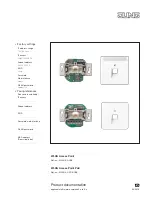
6
WLAN Access Point · Introduction
General
The WLAN Access Point offers a contemporary alternative to meet the requirements of mod-
ern network infrastructures according to DIN 18015-2 and RAL-RG 678, without sacrificing
the flexible use of modern, mobile technologies such as tablet PCs or laptops and restricting
the wireless data rates.
In addition, the WLAN Access Point works like a normal data outlet with RJ45 outlet for a
conventional data terminal (data rate 100 Mbit/s). Power is supplied directly via 230 V on the
back, via separate power supplies (REG devices) or in the case of special versions via
PoE
.
The WLAN Access Point is connected to the internal data network via classic copper data
cable.
The WLAN range can be adapted to the conditions prevailing in the room and limited to
the room. This results in powerful room radio cells, which ensure maximum wireless band-
width within the room and work with low power consumption and low radiation. Due to its
low energy requirement and thus low radio emission, delimitation problems under individual
access points and over-coupling of the WLAN areas or losses in the data rates are largely
avoided.
The WLAN Access Point can also be controlled directly via
UDP
and has extensive pro-
gramming, time switching and additional protocol functions (see page 31).
In principle, the following
functional principles (1.-3.) / application options (4.-8.)
can be
distinguished:
WLAN Access Point
1.
Access point:
WLAN Access Point as access point, bidirectional communication
of all WLAN terminals via the Cu interface to the router / internet
2.
Client:
Devices without a WLAN adapter (e.g. TV box) are becoming
‘WLAN-capable’, bidirectional communication
3.
Bridge:
Connection of two network segments via two WLAN Access Points, bidi-
rectional communication
4.
Repeater:
Range increase of a router or/and an WLAN Access Point through
another WLAN Access Point
5.
Roaming:
Free movement with mobile WLAN devices in all rooms, secure
identification of network IDs in all rooms (identical SSID)
6.
Guest:
Access to the Internet is possible via guest access, access to the in-house
network is not possible!
7.
Time-controlled LAN/WLAN:
The WLAN as well as the front socket can be
switched on and off in a time-controlled manner.
8.
Central programming:
Changes to the most important network configurations of
all WLAN Access Points via just one logon to the network
WLAN Access Point POE
-
PoE data exchange:
Connection / operation of additional class 2 / 6.49 W PoE
terminals (e.g. IP cameras) – the necessary voltage is provided by means of a PoE
injector or PoE switch.
Do not use the WLAN Access Point for any other purpose and use it indoors only.
Содержание WLAN-AC-POE-UAE
Страница 2: ...2...
Страница 50: ...50 WLAN Access Point Annex Notes...





















